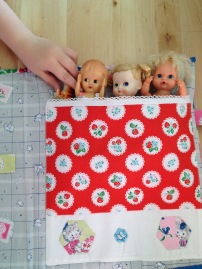I am very excited to be the first blogger on the blog tour for Amanda Brandl’s latest collection with Kennard and Kennard, Marsupials and Monotremes. This is the second time I’m working with Amanda’s sweet fabric designs, previously I was lucky enough to work with her Bush Gum Blossom collection.
I chose a few of the floral prints to use for my blog tour projects, I loved how they featured Australian native trees in beautiful non traditional colour ways.

For my first project I made a scallop trivet using the pattern from Sedef Imer’s latest book Zakka Home. I paired Amanda’s gorgeous Grevillea on Aqua design and Gum Leaf Shake in Pink and Aqua with a dark cream spotted fabric and hand quilted the trivet using Aurifil thread in 12 weight, with a little ribbon detail for the centre.

My second project I really wanted the bold scarlet print of the Grevillea on Red to be celebrated so I paired it with a linen and then added hand quilting using Aurifil Thread in complimentary red, blue and cream tones.

I didn’t use a pattern for my pot holder but simply cut out two rectangles ( 4 1/2 x 8 inches) in the linen and Grevillea on Red print then stitched the long edges together. I hand quilted a piece of insulated batting (8 x 8 inches) to the wrong side of the pot holder and then cut another piece of Amanda’s print in 8 x 8 inches for the back. I used a plate to draw round the corners and cut the excess fabric away to give me curved edges. I then made a quilt sandwich by putting right sides of fabric together and stitched them together using a 1/4 inch seam (leaving a gap to turn the pot holder out). I then hand stitched the gap closed and added a ribbon and wooden button. A really simple gift idea and perfect way to showcase the work of a talented young Australian designer!

Marsupials and Monotremes is a celebration of Australian animals and flora using Amanda’s signature aesthetic of combining beautiful colours and sweet illustrations.
I love that Amanda manages to capture the Australian landscape in a way that can be used for so many projects, from patchwork to clothes to whole quilts, and you will get to see great examples of these and many more during the Blog Tour over the next few weeks.
Tomorrow Kylie from Wombat and Poss is on and I can’t wait to see how Amanda’s designs have inspired her. To see the entire schedule of the tour pop over to Amanda’s blog page. You can also find out full details of stockists for the Marsupials and Monotremes collection on Amanda’s webpage and on the Kennard and Kennard webpage.
Happy Sewing!
Ange































 thick pencils so I measured 1 inch intervals along the length of pencil section. (Hint: if you are using thinner pencils you might be able to fit in extra pencils). I then top stitched a straight line down each inch interval (from the top to the bottom).
thick pencils so I measured 1 inch intervals along the length of pencil section. (Hint: if you are using thinner pencils you might be able to fit in extra pencils). I then top stitched a straight line down each inch interval (from the top to the bottom).



